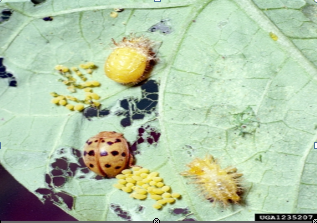Mexican bean leaf beetles are one of the few leaf-feeding beetles in the ladybird beetle family. The adult beetles and especially the larvae can cause economic leaf defoliation in a very short time. If beetles are found in a field, proper scouting methods should be utilized to determine infestation level and if economic thresholds have been met or surpassed.
Identification and Life Cycle
Mexican bean leaf beetles (MBLB) are about the size of ladybugs, oval-shaped, straw or cream-yellow in color and have eight black spots of variable size on each wing cover that are arranged in rows.1 With age, the beetles become more orange-brown with a bronze tinge and decreasing spot intensity.1 The beetles overwinter under residue and reappear in the spring through mid-summer. During the reproduction process, females lay clusters of pale yellow to orange-yellow eggs in a vertical position on the underside of the soybean leaf. At hatching, the larvae are light yellow with six longitudinal rows of hard, branched spines that are initially yellowish and later become darker at the tips. Prior to pupation, the larvae are greenish yellow (Figure 1).1

Impact on Soybean Crop
Both the larvae and beetles can cause economic damage; however, the larvae usually cause the most damage due to voracious feeding that commences at hatch. Depending on temperature, larval feeding occurs on leaf undersides for 2 to 5 weeks. As upper leaf surface tissue dries and falls away because of lower leaf surface feeding, a skeletonized leaf is left. Blossoms and small pods may also be fed upon. Beetles may feed on all plant parts; however, leaf tissue between the veins is preferred causing the leaves to have a lace-like appearance.
Management
Management can include:
- Culturally by destroying residue.
- Introduction or conservation of predatory insects that feed mostly on eggs, larvae, and pupae.
- Use of insecticides.
Residue destruction can rob adults of overwintering sites within the field. Systemic seed treatments and/or soil-applied insecticides may provide early beetle control; however, insecticidal activity may not last long enough to control beetles that emerge from winter habitat later in the season.
Threshold levels for larvae are in the range of 1 to 1.5 larvae/plant.1 While scouting, larval development should be noted as 3rd and 4th instar larvae are the most destructive. Purdue University suggests randomly selecting 2 plants in 5 field areas and counting the number of pods/plant and the number with feeding damage.2 An average feeding percentage can be calculated from the counts. The stage of pod development should be noted and a sweep net used to determine the average number of beetles present. Treatment thresholds may vary by state and region; therefore, local recommendations such as those from Purdue University should be reviewed (Table 1).

Sources:
1Mexican bean beetle. Featured Creatures. Entomology & Nematology. University of Florida. http://entnemdept.ufl.edu/.
2Mexican bean beetle. Field Crops IPM. Purdue University. https://extension.entm.purdue.edu/.
3Krupke, C.H., Obermeyer, J.L., and Bledsoe, L.W. Soybean insect control recommendations. Field Crops. E-77-W. Purdue Extension. Purdue University.
https://extension.entm.purdue.edu/. Web sites verified 8/27/18. 180829122903.
